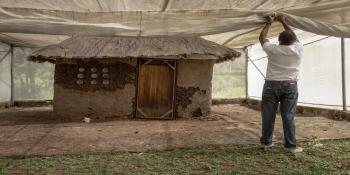
HABITAT FOR HUMANITY SEEKS NEW VENTILATION DESIGNS TO SOLVE AT-HOME MALARIA TRANSMISSION
NAIROBI (April 7, 2025) — Habitat for Humanity and SeaFreight Labs launched a new global open-innovation challenge to try to dramatically reduce malaria infections by targeting where most infections begin: at home. The challenge, which runs through 7 July 2025, includes a US$24,000 prize pool.
Although completely preventable, malaria remains one of the leading causes of death globally for children under the age of five. Curbing the disease’ spread is now more crucial than ever. Rising temperatures have enabled mosquitos to thrive in larger areas, while higher indoor temperature correlates to lower use of bed nets.
“Most malaria transmission occurs in the home, so that is where we must look to innovate,” says Roland Pearson, vice president and executive director of the Terwilliger Center for Innovation in Shelter, a division of Habitat for Humanity International. “Small changes in how households build can have an outsized impact on their health and well-being. Our goal is to identify and test housing solutions that are affordable and can be scalable to reach millions of low-income families.”
Habitat for Humanity and SeaFreight Labs have already identified and prototyped one such solution through a previous crowd-sourced innovation challenge in 2021. Initial research conducted in partnership with the Kenya Medical Research Institute found that solution, which uses air cavities constructed from affordable, locally available materials, was able to reduce mosquitos’ entry into the home by 89 percent.
“It was important to us that the solution not be a specific product households need to purchase, but rather a construction innovation that any mason building or renovating a house can construct and install independently,” explains Harry Sangree, founder and CEO of SeaFreight Labs. “For that reason, we are particularly eager for submissions from engineers, architects, interior designers, and others living in East Africa who understand local housing needs and construction preferences.”
The new challenge, “Reducing Malaria Spread with Improved Air Quality Ventilation,” asks solvers to refine the air cavity design into a viable and desirable alternative to conventional windows, while still preventing mosquito entry. Submissions are open until July 7, 2025 through HeroX, a crowd solving platform. Three shortlisted solutions will undergo field testing and will be awarded US$3,000, with the winning solution receiving an additional US$15,000 prize.
About Habitat for Humanity
Driven by the vision that everyone needs a decent place to live, Habitat for Humanity found its earliest inspirations as a grassroots movement on an interracial community farm in south Georgia. Since its founding in 1976, the Christian housing organization has grown to become a leading global nonprofit working in local communities across all 50 states and Puerto Rico in the U.S. and in more than 70 countries. Families and individuals in need of a hand up partner with Habitat for Humanity to build or improve a place they can call home. Habitat homeowners help build their own homes alongside volunteers and pay an affordable mortgage. Through financial support, volunteering or adding a voice to support affordable housing, everyone can help families achieve the strength, stability and self-reliance they need to build better lives for themselves. Through shelter, we empower. To learn more, visit habitat.org.
About SeaFreight Labs
SeaFreight Labs is a consultancy delivering crowd-solving services to businesses and non-profits. We serve as “Project Advisor” on global challenges to cost effectively deliver breakthrough innovation to intractable problems.